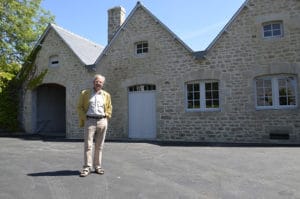" The notion of heritage refers to the history, roots and traces left by men and women over time in the environment, the living environment, know-how and the imagination. Today, it encompasses both tangible and intangible heritage. Over the years, it has expanded considerably. More and more Bretons have appropriated it. However, it has a personal and subjective dimension. For some, a particular element will have a heritage value, for others not. For former pupils, a school, even a relatively recent one in a rather banal style, may have a heritage character. In this case, both its architectural interest and its sentimental dimension come into play. "Serge Duigou, local historian
After ten years as a journalist, Serge Duigou turned to history. He became involved with the Association of Friends of the Alexis Le Gall Cannery (ACAL) as part of the museum project launched in 2016. A connoisseur of the history of Loctudy and the Bigouden region, he has put his skills at the service of the project in order to better situate this industrial heritage in the socio-economic context of the turn of the 20th century. He tells us about the challenges he had to face on this occasion.
his background professional
I have been a historian for about forty years. I wasn't always a historian. I wanted to become a teacher. I studied literature in Brest. But, at the end of these studies, I realised that this was not my vocation. I was a journalist for about ten years. I started to do historical research in parallel, for my own pleasure. At first, it was just a hobby. One thing leading to another, I made it my profession. I specialised in the history of Brittany, starting with the Bigouden region, where I come from. I have put the fruit of my research into books, articles, conferences and guided tours in the field.
its notion of heritage
The notion of heritage refers to the history, the roots and the traces that people have left over time in the environment, the living environment, the know-how and the imagination. It encompasses both tangible and intangible heritage. Initially, I was mainly interested in tangible heritage (calvaries, chapels, churches, manors, megaliths, etc.). In a second phase, stimulated by my wife, who has a passion for thread crafts, embroidery and lace and is president of the association of the Friends of the Bigouden Museum, I plunged into the ethnographic heritage of the Bigouden region, a fascinating field which we have not finished exploring.
At the beginning, when I started to be interested in heritage - it was in the 1960's - the old buildings largely prevailed. Later, the notion of "small heritage" (washhouses, fountains, mills, etc.) emerged. Finally, more recently, ethnological and industrial heritage has been recognised. Forty years ago, industrial heritage was little known and little considered. It is easier to spot a calvary or a manor house than an old factory. Until recently, it was more rewarding to fight to save an endangered chapel than a disused cannery!
Over the years, the notion of heritage has therefore been broadened. People have also become aware in the coastal regions that there is a significant maritime heritage. The magazine Le Chasse-Marée from Douarnenez has done a remarkable job in order to promote it. It has succeeded in popularising this notion, in making it intelligible and accessible to the general public.
Heritage is now recognised by a growing number of our fellow citizens. More and more Bretons have appropriated it. However, this notion has a personal, subjective dimension. For some people, such and such an element will have a heritage value, for others not. For former pupils, their primary school, even if it is relatively recent and of a rather ordinary style, may have a heritage character. In this case, both its architectural interest and its sentimental dimension come into play. In short, the notion of heritage, which is versatile and evolving, leads to debate within the population. In this sense, it is stimulating.
Its role in the of the museum project
I participated in the museum project with the Association des Amis de la conserverie Alexis Le Gall (ACAL) as a historian. Initially, not being from this environment, I had little knowledge of fish canning techniques. On the other hand, I have done a lot of work on the history of Loctudy and the Bigouden region in general.
My role was first to contextualise the place and contribution of the cannery within the socio-economic history of the commune. The factory played a significant role at the beginning of the 20th century in Loctudy at a time when the locality, originally exclusively rural, was gradually turning towards the sea. I have tried to highlight the role of the cannery in this historical transition. It stimulated the development of the port by offering new outlets to fishermen. Before the factory was built, the port of Loctudy had few fishing boats. Three years after its opening, the fleet had doubled. Not only did the cannery play a role in creating jobs, especially for women, but it also contributed to the town's long-term commitment to maritime activities.
I was also led to underline the singularity of the location of the cannery, built in the seaside sector of Loctudy, near bourgeois villas and a hotel. This is an original configuration. The immediate neighbours of the factory, the hotel owner and the owners who welcomed tourists during the Belle Époque, might have taken a dim view of the installation of such a building. It was therefore interesting to determine the identity of the founder and to show how the Vallière des Filières family positioned itself in the local bourgeoisie. These economic, geographical and sociological aspects were among the aspects I looked at.
Finally, I participated in the iconographic enrichment of the future museum.
its great challenges
We were confronted with a relative scarcity of public archives for the first period of the factory. The archives of a company are rarely kept once the activity has ceased. They do not end up in the departmental archives. When an industrial establishment closes, the archives are either thrown away or at best distributed among the members of the factory owner's family. Over the decades and through family succession, they are dispersed, crumbled among the descendants and eventually disappear.
In the case of the Le Gall cannery, we are fortunate that Mr Jean-Philippe Chapalain and his wife kept the archives of the factory from its purchase by Alexis during the First World War. However, this was apparently not the case for the documents of the family that preceded the Le Galls, the one that built the cannery in 1901. There is little trace of the Vallières des Filières' activity in the local press, except in 1909 when a strike of the workers took place. In this regard, I would like to pay tribute to the remarkable archival research work carried out by Marie Prigent-Viegas and Amélie Garrot-Hascoët.
As far as images are concerned, we are still not satisfied. The only photos we have at present to illustrate the Vallière period are the two postcards of the sardine workers working around the drying tables in the yard in front of the factory. We have no portraits of the family. It is a great frustration not to have any pictorial representation of the founder of the factory. The written data are fundamental but they do not have the strong visual impact of photographs, especially for a museum. The photographs give a human dimension to the discourse and leave a mark on the mind through facial expressions, attitudes, gestures, clothing, etc. I still hope that one day, when the museum is open to the public, some of the Vallière descendants will contact us to send us family photos.
The second challenge, which was quite personal to me, was that I knew very little about canning techniques. Thanks to my colleagues in the working group, I have made some progress!
its best souvenir
I have several. The experience has interested me a lot, taught me a lot and given me many satisfactions. First of all, with all the actors, the municipal councillors (first of all Jean Laouénan and Pierre Quillivic), the professionals, the two successive presidents of the association, Guy Cosnard and Pierre-Jean Desfossé, and all the volunteers of ACAL, we worked in an excellent atmosphere of mutual trust and listening. Our different skills and backgrounds were not an obstacle but a plus for the project. I would like to pay tribute to Jean Laouénan's tenacity and sense of diplomacy, a man of dialogue who has always been concerned with smoothing out the rough edges and reaching an agreement with the various players in the project.
Secondly, I was pleased to note that each time we organised open doors, information sessions and conferences around the museum project, many Loctudists attended. At the September 2020 Heritage Days open house, they lined up patiently. Elected officials and members of the association were present to welcome them. We didn't stop for two days. We had to turn away some visitors in order to keep the number of visitors to a minimum. The feedback from the public was very positive. The Alexis Le Gall Cannery Museum is gradually but surely becoming a part of the local landscape and people's minds.
I am especially pleased that the museum project, which was complicated and not obvious, has been completed, a long-standing project since Jean-Philippe Chapalain, the owner of the premises with his wife, had it in mind for over thirty years. This ambitious project could very well not have seen the light of day, as the challenges to be met were considerable. It was quite a gamble, but it is on the way to being won. The next opening of the museum will not mean the end of the adventure. It will develop, grow and become even more attractive over the years.


